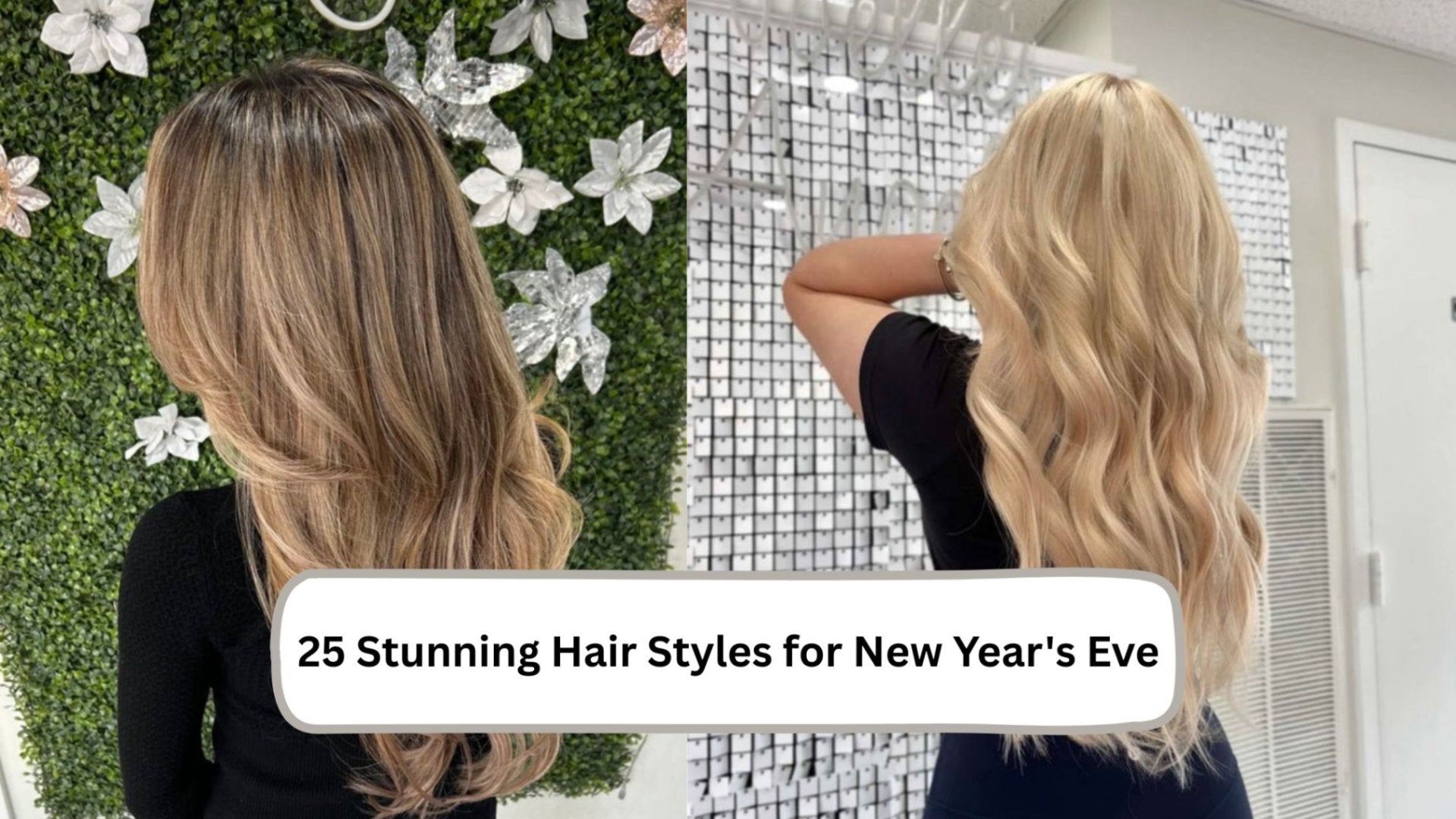How to Make Synthetic Hair Extensions Soft and Silky Again
Key Highlights
-
Synthetic extensions are made from fibers, not natural hair.
-
Stiffness comes when the factory coating wears off.
-
Softening is key for comfort, style, and durability.
-
Shine sprays, silk wraps, and storage maintain silkiness.
-
Fabric softener soaks reduce static if used sparingly.
-
Professional care revives extensions when DIY fails.
Have you ever run your fingers through your hair extensions only to feel them stiff, scratchy, and nothing like the silky locks you imagined? It's disappointing, especially when you've invested your time and money into looking and feeling your best.
Synthetic extensions are great for adding instant length and volume, but once they lose their softness, they can start to look dull and feel uncomfortable. That rough texture not only makes styling harder but also detracts from the confidence extensions are meant to convey.
If you've been wondering how to make synthetic hair extensions soft again, you're not alone. In this guide, you'll discover easy at-home fixes, salon-level solutions, and expert tips from Noelle Salon to keep your extensions soft, silky, and natural-looking.
What Is A Synthetic Hair Extension, And How Does It Differ From Human Hair?

Synthetic extensions are made from fibers like acrylic, polyester, or Kanekalon. They’re designed to look like natural locks, but unlike human hair, they can’t absorb oils or moisture. Their smooth feel comes from a factory coating, not from actual nourishment.
Here’s where the difference shows up:
-
Human hair extensions can soak up conditioners and oils, but synthetic fibers cannot.
-
Synthetic strands feel soft at first, but once the coating fades, they turn rough and tangled.
-
Human hair handles heat styling. Synthetic hair? Excessive heat can warp or melt it.
-
With the right TLC, human hair lasts longer. Synthetic extensions need gentler routines to keep their softness.
They may look alike, but synthetic extensions have one big weakness: stiffness. Let’s break down why they lose their softness so quickly.
Why Do Synthetic Hair Extensions Get Stiff Or Damaged Over Time?

Synthetic hair extensions start out silky because of a special coating applied during manufacturing. Once that coating wears off, the fibers can quickly lose their softness.
Everyday habits make this worse, such as:
-
Hot Tools and Hot Water: Heat can warp or even melt synthetic strands.
-
Rough Brushing: Pulling too hard can damage fibers and create frizz.
-
Product Buildup: Heavy sprays, gels, or oils leave residue that stiffens hair.
-
Friction While Sleeping: No protection means tangling, frizz, and rough ends.
-
Poor Storage: Tossing them aside or leaving them tangled shortens their lifespan.
The bottom line? Synthetic extensions aren't like human hair. Without the proper care, they stiffen quickly, but with the right routine, you can keep them soft and silky much longer.
Also Read: Easy Guide: How to Spot Fake Hair Extensions
Why Softening Your Synthetic Hair Extensions Is Important?

Silky extensions look natural and last, while stiff strands scream fake and fall flat. Here's why learning how to make synthetic hair extensions soft really matters:
-
Natural Look: Soft fibers move and shine like real hair, helping your extensions stay undetectable.
-
Comfort Factor: Stiff, rough strands can feel scratchy against your skin, while soft extensions remain light and easy to wear.
-
Style Versatility: Silky extensions brush and style easily, unlike stiff ones that snag and resist.
-
Longer Lifespan: The softer you keep them, the less likely they are to frizz, tangle, or snap.
-
Confidence Boost: Soft, silky extensions not only look better, but they also make you feel better, too.
Keeping synthetic hair extensions soft isn't optional. It's the secret to making them look flawless, feel comfortable, and truly worth your investment.
How Do You Bring Synthetic Hair Extensions Back to Softness?

Extensions feeling stiff? Frizzy? Not blending like they used to? Don't stress; here's the step-by-step process on how to make synthetic hair extensions soft again. Follow these steps, and you'll bring them back to life.
Step 1: Detangle Gently
Grab a wide-tooth comb and start at the ends. Work your way up slowly. No yanking, no tugging.
Why? Rough brushing causes breakage and frizz. Gentle detangling helps keep the fibers intact and prepares them for washing. If you want to keep hair extensions soft and silky, this first step is non-negotiable.
Step 2: Wash With Cool Water
Fill a basin with cool or lukewarm water. Add a drop of sulfate-free shampoo and gently swirl the extensions.
Hot water? Forget it. It strips the coating and ruins the fibers. Cool water helps you keep hair extensions soft, shiny, and manageable. A gentle wash is the best foundation for restoring softness.
Step 3: Apply a Synthetic-Safe Conditioner
Next, coat the strands with a conditioner made for synthetic hair. Let it sit for a few minutes.
Synthetic fibers don't absorb like human hair. This conditioner simply coats and smooths, which is exactly how to soften synthetic hair extensions without damage. It adds that much-needed slip so brushing later feels effortless.
Step 4: Try the Fabric Softener Soak (Optional)
Want extra softness? Mix one part fabric softener with three parts water. Soak for 10 minutes, then rinse well.
It's a quick fix for frizz and static. Just don't overdo it; too much leaves buildup instead of shine. Use it sparingly, and it becomes one of the easiest tricks on how to make hair extensions soft again at home.
Step 5: Rinse Thoroughly and Pat Dry
Rinse with cool water until the product's gone. Lay flat on a towel. Pat, don't rub.
This keeps fibers aligned and smooth. It's a small detail, but it's what makes hair extensions soft again at home. Skipping this step often leads to stiffness coming back faster.
Step 6: Let Them Air Dry Flat
Leave them on a towel or wig stand until completely dry. Flip halfway through.
Skip the blow dryer unless your extensions are heat-friendly. Air drying is the safest route to keep synthetic extensions soft. It may take longer, but patience pays off with silky results.
Step 7: Add Shine With a Finishing Spray
Once dry, mist lightly with a synthetic-safe shine spray. Comb through for even coverage.
This is how to make hair extensions soft and shiny instantly. Just one spritz and the dullness is gone. A light shine spray also reduces static, making styling much easier.
Step 8: Protect Extensions While Sleeping
Wearing them overnight? Wrap in silk. Or switch to a satin pillowcase.
Friction is the enemy. Smooth fabrics protect fibers and help you keep hair extensions soft and silky. Think of it as beauty sleep for your hair; it matters as much as your skincare routine.
Step 9: Store Extensions Properly
Brush them out. Place them in a breathable bag or box. Keep them neat.
Tossing them in a drawer is the fastest way to shorten their lifespan. Proper storage means softer strands next time you wear them. When stored right, extensions can last far longer than you'd expect.
Step 10: Refresh With Professional Care
Tried everything and they're still stiff? Time to go pro.
Noelle Salon specializes in restoring softness with expert care and salon-grade products. Book your free consult today.
How To Keep Hair Extensions Soft And Silky (common mistakes and how to avoid them)

Making your synthetic hair extensions soft is one thing. Keeping them that way is the real game-changer. With the right habits, you can enjoy silky, natural-looking hair for weeks instead of days. Here's how:
-
Brush With Care Every Day: Use a wide-tooth comb or extension brush, starting at the ends of the hair. Gentle brushing keeps fibers smooth and prevents tangling before it even begins.
-
Use Sprays The Smart Way: A light detangling or shine spray designed for synthetic hair goes a long way. Avoid heavy products that cling to fibers and make them stiff again.
-
Protect While You Sleep: Friction is your biggest enemy. Sleeping on a satin pillowcase or wrapping your extensions in silk helps reduce frizz and keeps your hair extensions soft overnight.
-
Wash Only When Needed: Overwashing shortens the life of synthetic hair. Stick to washing after 10–15 wears or when you notice buildup. Less is more here.
-
Store Them Like a Pro: When not in use, brush and place your extensions in a breathable bag or box. Neat storage means fewer tangles and longer-lasting softness.
The goal isn’t just to fix stiffness but to prevent it from returning. Follow these habits, and you’ll not only know how to make hair extensions soft again at home, you’ll also master the art of keeping them silky for the long run.
Also read: Beginner's Guide: How to Take Care of Hair Extensions
Tired Of Stiff, Lifeless Extensions? Here's Your Fix
Stiff, tangled extensions can ruin your look and your confidence. DIY tricks help for a while, but when nothing seems to work, it's frustrating.
That's where Noelle Salon makes the difference. Our experts specialize in restoring softness, shine, and manageability, whether it's synthetic hair extensions or human hair options. We take the guesswork out and give you results that last.
And once your extensions are revived, maintaining them becomes effortless.
Why Choose Noelle Salon?
-
Free consultations to find the right solution for your hair.
-
Same-day services with multiple extension methods in stock.
-
Our own Veila Hair Extensions for natural, long-lasting results.
-
Over 35 years of trusted expertise in extension care.
Book your free consultation today at Noelle Salon and bring your extensions back to soft, silky life.
Conclusion
Softening synthetic hair extensions doesn’t have to be complicated. With the right steps and consistent care, you can bring back that silky feel and keep your extensions looking fresh for longer.
Now it’s your turn. Start by trying one of these methods today, then build a simple routine to maintain the results. And if you’re ready to go deeper, check out our next guide on advanced care tips to keep your extensions flawless.
Frequently Asked Questions
How often should I treat my synthetic hair extensions for softness?
Wash every 15–20 wears or when buildup shows. Use a lightweight leave-in or silicone spray more often. Regular TLC helps maintain softness, shine, and longevity without stressing the fibers.
Can I use regular conditioner or oil on synthetic hair extensions?
Avoid traditional conditioners and oils designed for natural locks. They leave residue that weighs down synthetic fibers. Instead, choose lightweight, water-based products made specifically for this type of hair.
Is boiling water safe to use for softening synthetic hair extensions?
No, boiling water or excessive heat can melt synthetic fibers. Unless labeled heat-friendly, skip heat styling altogether. Stick to cool or lukewarm rinses to protect softness and prevent permanent damage.
Can I use hairspray on synthetic hair extensions?
Traditional hairspray builds up quickly on synthetic strands and makes them stiff. Use sprays formulated for synthetic hair; they’re lightweight, less sticky, and easier to wash out, keeping your extensions soft.
How can I increase the longevity of my synthetic hair extensions?
Limit washing, store them neatly, and avoid excessive heat. A little TLC like brushing gently, using satin at night, and avoiding heavy products can helps your extensions last longer and look silky.
Do synthetic extensions need the same care as natural locks?
Not quite. Unlike natural locks, synthetic fibers can’t absorb oils or deep conditioners. They rely on surface-level care, shine sprays, and gentle washing to stay soft and manageable.
How to soften human hair dreadlock extensions?
Use a residue-free shampoo and follow with a lightweight oil like argan or jojoba to add moisture. Regular palm rolling and TLC keep the locs neat, while avoiding heavy creams prevents buildup inside the extensions.
What type of hair care routine keeps synthetic extensions silky?
A lightweight routine works best: detangle daily, wash sparingly, use synthetic-safe conditioner, and protect while sleeping. Too much product or heat styling weakens fibers, while consistent TLC keeps them smooth.
Can heat styling ever be used on synthetic hair extensions?
Only if they’re labeled heat-friendly. Even then, use the lowest setting to avoid excessive heat damage. For most synthetic hair, it’s safer to style without direct heat to maintain softness.
How to soften/smooth the ends of a synthetic wig?
To soften and smooth the ends of a synthetic wig, use a gentle fabric softener mixed with water in a spray bottle. Lightly mist the ends, then comb through with a wide-toothed comb. Avoid excessive heat, as it can damage synthetic fibers. Regular maintenance keeps your wig looking fabulous!
Do certain synthetic hair extension brands stay softer than others?
Yes, some brands use higher-quality fibers that feel more like natural locks and hold softness longer. Longevity depends on the type of hair used, factory coating, and how much TLC you give your extensions.




